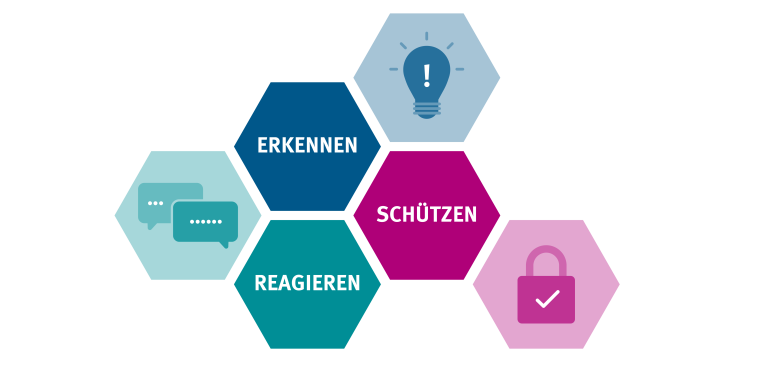

Informationssicherheit ERKENNEN, SCHÜTZEN, REAGIEREN
Informationssicherheit ist eine Gemeinschaftsaufgabe aller Mitarbeitenden, Studierenden und Angehörigen der Universität Münster. Erkennen-Schützen-Reagieren stellt dabei einen Dreischritt aus Kompetenzen dar, der den Umgang mit Informationssicherheit in Ihrem Arbeitsalltag zugänglicher machen soll.
Im Bereich Erkennen erhalten Sie Informationen zu potenziellen Gefahren, Vorgehensweisen von Angreifenden und dem Wert Ihrer Informationen.
Der Bereich Schützen gibt Ihnen konkrete Handlunghinweise, Step-by-Step-Anleitungen und nützliche Tipps zur Umsetzung einer sicheren Arbeitsweise in Ihrem Arbeitsalltag an die Hand.
In dem Bereich Reagieren finden Sie Anhaltspunkte, wie Sie einen sicherheitskritischen Vorfall erkennen können, wie Sie sich in solch einem Fall verhalten und an wen Sie sich sofort wenden können.
Schulungen zur IT- und Informationssicherheit
Checklisten
Nutzen Sie unsere Checkliste IT-Sicherheit, um Schritt für Schritt die nötigen IT-Sicherheitsmaßnahmen an Ihrem Arbeitsplatz umzusetzen.
Nutzen Sie unsere Checkliste: Betrügerische E-Mails erkennen, um Phishing- und andere schädliche E-Mails zu erkennen und sich vor ihnen zu schützen.
Nutzen Sie außerdem unsere Notfallkarte, damit Sie, falls Sie nicht mehr auf das Internet zugreifen können, Ihre zuständigen Kontaktpersonen erreichen können.
Warnung vor aktuellen Phishing-E-Mails
Aktuell werden vermehrt Phishing-E-Mails an viele Angehörige der Universität Münster verschickt.
Die E-Mails haben den Betreff "Sie haben zwei wichtige Nachrichten von der Universität Münster erhalten, die nicht zugestellt werden konnten Aufgrund einer Systemstörung." und behaupten, dass einige Nachrichten aufgrund einer Störung nicht zugestellt werden konnten und daher eine "Wiederherstellung" notwendig sei. Als Absender wird "UNIVERSITÄT MÜNSTER- KONTAKT" mit einer internen Absende-Adresse vorgetäuscht. Der Link führt allerdings auf eine externe Webseite, die unter der Kontrolle der Angreifenden steht und eingegebene Anmeldedaten an die Urheber weiterleitet. Dabei wurde die echte Login-Webseite der Universität Münster detailgetreu nachgebaut.
Warnung vor aktuellen Phishing-E-Mails
Aktuell werden vermehrt Phishing-E-Mails an viele Angehörige der Universität Münster verschickt.
Die aktuellen E-Mails wurden von unterschiedlichen externen Adressen verschickt und täuschen vor, dass der Speicherplatz des Postfachs voll sei und Maßnahmen notwendig sind. Dabei konnten unterschiedliche Titel beobachtet werden, wie "Sie nutzen derzeit 100% Ihrer gesamten Speicherkapazität. Bitte geben Sie sofort Speicherplatz frei.", "Sie haben 100% Ihres Speicherplatzlimits erreicht. Es sind Maßnahmen erforderlich, um Probleme zu vermeiden." oder "Bitte archivieren oder löschen Sie die Dateien. Ihre Dateien.". Die E-Mails enthalten Links, die auf eine Webseite weiterleiten, die täuschend echt die Anmelde-Oberfläche der Universität Münster nachbildet, aber von Kriminellen kontrolliert wird.
Warnung vor aktuellen Phishing-E-Mails
Aktuell werden vermehrt Phishing-E-Mails an viele Angehörige der Universität Münster verschickt.
Die beobachteten E-Mails haben den Betreff "Routine für die Lohn- und Gehaltsabrechnung der Mitarbeiter" und werden von externen E-Mail-Adressen, unter anderem mit dem Absende-Namen "Simon László", verschickt. Sie fordern Empfangende auf, ihre "Verdienstabrechnung" zu kontrollieren, wobei auf eine externe Webseite verlinkt wird, die von den Angreifenden kontrolliert wird und Zugangsdaten sammelt.

